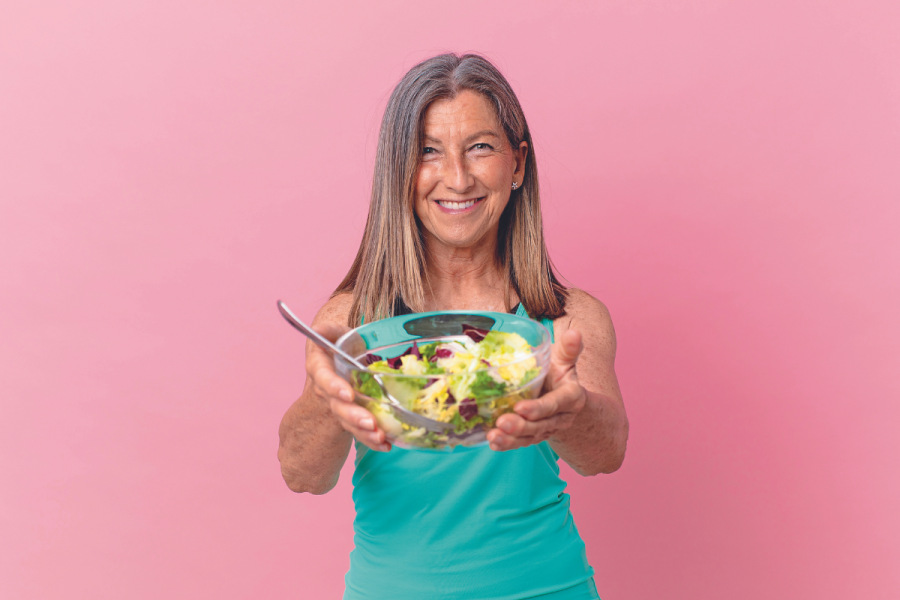Menopause transition specialist, nutritionist and health coach James Ellis specialises in helping stressed women aged 40-plus regain their health and vitality through simple, easy-to-cook meals and other lifestyle interventions. Here, he shares 3 tips on how to eat well for life…
Meet Mandy. She’s 44 and has a successful career in sales for a multinational mobile phone company. With two children under 10, her morning routine is a dance of precision and timing, balancing her family’s needs with professional demands. The problem is, in this whirl of activity, her own needs often get missed.
Not only does she have the children to care for, but her parents are ageing and need support. She also wants to be a great partner to her husband, be there for all her friends, and still perform like the female boss she is. Her job is demanding. There are calls at all hours, emails to answer, and fires to put out. Little wonder she’s so busy looking after everyone else, she hardly gets enough time to look after herself.
If elements of Mandy’s story seem familiar, it’s because her circumstances are common among women over 40 who come to me for nutrition or health coaching when peri- or menopause symptoms hit. While there’s an outside dance going on, inside, there’s another complex interaction between the hormones involved with sleep, hunger, stress, metabolism, and sex. This can all influence homeostasis, your body’s ability to find internal balance. Think of hormones like an orchestra: you want all the instruments to be in tune and keep the same beat to make sweet music.
The problem with Mandy’s situation is more than just not finding time for herself. The pressure of feeling as if she needs to show up all the time is causing her tremendous stress and, unfortunately, stress is the number one enemy of women with changing hormones.
The Stress Effect
Stress and internal balance are part of your autonomic nervous system – the one that looks after things you don’t have to think about, such as heartbeat, breathing, digestion, and blood pressure. Your nervous system has two branches: one that deals with fight, flight, or freeze (the sympathetic nervous system), which is the one you’re probably most familiar with.
When your heart rate increases, stress hormones such as adrenalin and cortisol spike, and digestion shuts down. This is useful in true emergency situations but less so when dealing with the constant background noise of low-level stress that modern life brings.

The other strand of the nervous system, which helps you achieve balance and recovery, is the parasympathetic or “rest and digest” system. Unfortunately, it’s the one most of us spend less time in but is equally crucial for wellbeing.
For example, if you’re eating when you’re stressed and “fight or flight” is activated, then however good the food is, you’re not going to digest it well and won’t get the most benefits from it. What’s more, your blood sugar balance may also be compromised due to stress, adding even more fuel to the hormonal symptoms fire.
Always in a Rush
To complete Mandy’s story, after a stressful time getting the kids to school, she grabs a slice of toast with avocado and a protein shake and jumps in the car, eating while battling traffic on the way to the office. It’s a busy day at work with a big project on the go, so she grabs a chicken sandwich from the canteen for lunch, eating it at her desk while answering some emails from a stressed-out client. By 3pm, she’s feeling wired and tired but grabs a coffee and a bar of chocolate, thinking of the 80:20 rule that says she only needs to be “good” 80 per cent of the time.
Later, with no time to cook something healthy, she grabs a ready meal from the fridge for her and the kids, eating around 8pm. She’s in bed by 9pm, thinking she needs to get an early night, but sleep is lacking as she’s thinking about the project and the 3pm coffee is doing its magic. She jumps on her phone, filling her mind with more work stress or doom scrolling, and getting a dose of excitatory blue light from the screen. She finally gets to sleep around 11pm but has disrupted sleep due to work worries.
The following morning, she gets up, too tired to go to the gym. With her hunger hormones off-kilter, she’s choosing a carb-filled breakfast on the go, or heading straight to the vending machine for a chocolate bar to kick off the whole cycle again.
The negative talk in her head tells her she’s a failure because she’s not putting all the beneficial stuff she knows she “should” be doing into practice. If this sounds exaggerated, it’s not. I see this all the time with my clients, and it’s why I tend to work on three things before we even get to what’s on their plate from a nutrition point of view. See if you can do these too.

1. Take Care of Yourself
None of the aforementioned means Mandy is a failure, whatever societal norms might be telling her. It means she’s overloaded with responsibilities and has no chance to find balance. Accepting that bumps in the road happen, rather than criticizing her own abilities, is crucial.
The airplane oxygen mask analogy of looking after oneself before taking care of others is at risk of becoming a cliché, but clichés tend to become clichés because they happen so regularly. If Mandy doesn’t look after herself, what happens to all the people she cares about when she burns out? Just appreciating that self-care is not selfish can be a massive step forward.
2. Use Time Management
Stress itself is not a problem, but not having balance through a lack of parasympathetic nervous system activity certainly is. Self-care needs to be daily – even if only for 10 minutes – and it needs to be diarized in pen, which means time management is crucial. If you struggle with finding time, keep a time diary for a couple of days.
Reviewing it later can often reveal wasted time or help identify areas to save time. As part of time management, I encourage meal planning. It’s more than a time-saving hack; it’s an act of true self-care. It can help with reducing snacking and weight management. With a good idea of what to eat, you limit just grabbing something convenient when hungry (Instead, try these 8 low-carb snacks, swaps and recipes if you’re short on ideas!).
Involving any children in the house can also help reduce the stress of fussy eaters at mealtimes. Make a list of everyone’s favorite foods, then draw up a spreadsheet to plan as many meals as you can. Open new tabs on the sheet each week to make a new plan. Once you have 4-5 weeks’ worth, go back to the beginning.
3. Prioritize How You Eat
This brings elements of both the above together. The digestive process is crucial during the menopause transition years as you want to get the best value from your food, both from a nutrition perspective and to help balance your blood sugars. That means making enough time to eat and not rushing – no phones, laptops, or distractions.
Try having at least one meal where you sit down together as a family. Discuss what everyone’s done for the day, turn it into a gratitude practice, or play a simple, fun game like hangman. Digestion starts with seeing and smelling the food but really kicks in when in the mouth, so eating slowly and chewing food thoroughly can really help.

SIMPLE HACKS TO EAT WELL
Focus on protein. You need protein for many reasons: it keeps you fuller longer, helps with muscle mass, and makes hormones and enzymes. Try to get a palm-sized portion in at every meal. Next, try a fist-full of colored veggies, a thumb of good fats (avocado, nut butters, olive oil, pesto), and a cupped hand of starchy carbs (including fruit).
Cook from scratch. It’s not always possible in today’s world, but cooking from scratch and reducing highly processed foods as much as you can will always give you better nutrition. Batch cook and prep some foods from your meal plan at weekends to eat better, reduce any nasties in the food that can also affect hormones, and save money too.
Include phytoestrogens. These plant-derived compounds may help lower the risk of osteoporosis, heart disease, breast cancer, and menopausal symptoms. Try whole and minimally processed foods: flaxseed, firm tofu (found in the chilled aisle of the supermarket), edamame beans, and other legumes.
Make small changes. One reason many popular diets don’t last is they ask you to change too much at once. While willpower may help you get through a few weeks, eventually the changes seem too much, and you pine for old foods and habits. Instead of trying to do everything at once, ask yourself: what is the smallest change I am 90 percent confident I can make stick? When you have an idea, try it for a week or two.
Done it? Brilliant.Congratulate yourself, pick another change, and move on. Didn’t make it? Assess rationally what happened and see what the reasons were. It may well have been that the goal was too big. If so, reduce it and try again. For example, you’re confident you can add a palm of protein at both lunch and dinner every day of the week but find yourself struggling at lunch and only hit it twice. Change your goal to protein with every dinner and four times at lunch. When you hit four lunches consistently, aim for more!
How to Elevate Your Cooking
I founded Elevated Food For Life along with Michelin-trained chef Jason Shaw to help people learn how to cook simple, healthy meals themselves. Recipes are simple and easy to follow thanks to video instruction. We’ve come up with an eating guide that includes making two of our Brilliant Bases (core bases you make at the weekend to use all week).
These can then be used throughout the week to make spin-off healthy meals in double-quick time. It’s batch cooking without having to eat lasagna every night for a week! See elevatedfoodforlife.com for more information and recipes.
James Ellis is a nutritionist and health coach who specializes in helping women aged 40-plus with their health, happiness, and hormones. He offers a free, no-obligation call for women in the menopause transition: visit fabulousbeyond40.com. He is also the co-founder of Elevated Food For Life (elevatedfoodforlife.com) where you can access a whole week of recipes with a full shopping list. To sign up as a member and get a lifetime discount of 50 percent off the low-cost subscription, use the code TOPSANTE50 at the checkout.
Words: James Ellis. Images: Shutterstock.








